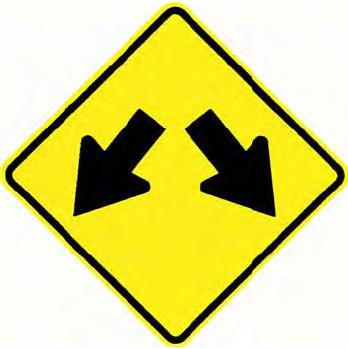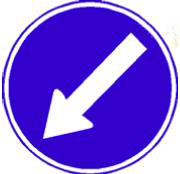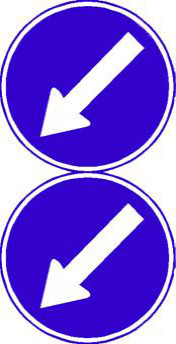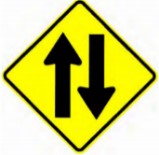There are a number of signs that can be used to highlight traffic islands, median barrier terminals, or other features located within the roadway.
In summary:
Where the feature is located on a road which is illuminated and vehicle speeds are low, the signs may be omitted if the RCA considers that it is safe to do so.
Table 6‑1 describes signs that should be installed to alert road users they are approaching a feature within the roadway that may require the road user to deviate from a straight path along the roadway.
Table 6‑1: Signs for diverge and keep left for features within the roadway
|
Sign code |
Example |
Description/use |
|---|---|---|
|
W14-1 Diverge |
 |
May be installed where traffic lanes carrying traffic in the same direction diverge and pass to each side of a hazard such as a kerbed traffic island, bridge support or similar substantial obstruction. Owing to the visibility obstruction that these signs create, they should only be used where other cues have failed. The hazard (other than kerbing) should be painted white to a height of 1.7m above road level. See notes 1, 2, and 3 for sign location. |
|
R3-13 Keep left – single disc |
 |
An R3-13 sign should be installed at or near the nose of a hazard to face approaching traffic where traffic must pass to the left of the island nose. For sign location, see notes 2, 3, and 4. |
|
R3-13.1 Keep left – twin disc |
 |
Where the hazard is so narrow that an R3-13 sign would be (or is being damaged) by turning vehicles the alternative R3-13.1 sign should be used. For sign location, see notes 2, 3, and 4. |
Table 6-1 notes:
| Operating speed | Distance |
|---|---|
| 50km/h | 65m |
| 70km/h | 100m |
| 80km/h | 120m |
| 90km/h | 140m |
| 100km/h | 160m |
On departure from a feature, for which road users have had to move laterally and / or diverge, information may need to be provided to remind road users that the feature has been passed. For example, a two-way sign can be used to advise road users that the centre-line marking divides opposing traffic flows; refer to Table 6‑2.
Table 6‑2: Signs for lane management
|
Sign code |
Example |
Description/use |
|---|---|---|
|
W14-2 Two-way |
 |
W14-2 signs should be installed:
Should not be used to indicate sections of narrow two-way road. In such situations, W13-1 Road narrows -left or right side or W13-1.1 Road narrows – both sides signs should be used. W14-2 and W13-1.2 Two-way [distance] ahead supplementary signs should be installed in advance of W14-2 signs or the first of any series of W14-2 signs. For sign location, refer to note 1. |
Table 6‑2 note:
| Operating speed | Distance |
|---|---|
| 50km/h | 65m |
| 70km/h | 100m |
| 80km/h | 120m |
| 90km/h | 140m |
| 100km/h | 160m |